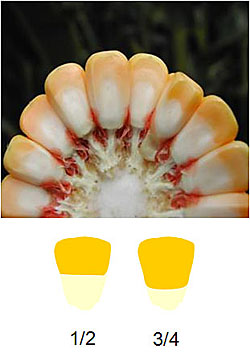Competency Area 2: Crop Staging, Growth and Development
PO 9. Know how to calculate Growing Degree Days (GDD) according to the 86 - 50 system. Know how environmental effects such as water stress or photoperiod affect the accuracy of GDD in predicting growth and development of corn.
Crops that respond to day length (actually responding to night length) are photoperiodic-sensitive.
Short-day crops, like corn begin the reproductive phase when day length is shorter than critical threshold--i.e. <15hr. Hybrids with different maturities (i.e. 90 vs.100 day corn hybrid) respond to different photoperiodic lengths (i.e., 90 day hybrid may begin the reproductive process when day length is less than 15 hr, whereas the 100 day hybrid may begin the reproductive process when day length is less than 14 hr and 45 min.)
Day-neutral crops –day length does not affect their flowering –soybean varieties grown in the Northeast are day-neutral and respond to temperature (soybeans that are grown in southern regions are photoperiodic and considered a short-day crop and will begin the reproductive process when day length is less than a critical threshold).)
Long-day crops-begin flowering when day length exceeds critical threshold level-wheat and rye are long-day crops and begin the reproductive process once day length exceeds a critical threshold.
Vernalization — an extended period of cold temperatures required to induce reproductive development in crops. Winter annuals such as winter wheat, winter canola, and rye require vernalization for reproductive development. If you plant winter wheat in the spring, it may grow like a bunch grass and may not elongate or head out.
Growing degree day or heat unit
- Summary of daily average temperature that assumes that the rate of growth or development of the crop increases linearly with an increase in temperature above a base temperature to a maximum temperature.
- Most GDD or heat unit systems have a base temperature that assumes minimum or no growth below the base.
- Most systems have cut-off values that limit maximum and minimum temperatures.
- Most GDD systems are used to classify corn hybrid maturity ratings.
Basis for and calculation of GDD
Now used in Cornell Guide for Integrated Field Crop Management
This calculation is based on the observation that corn does not grow much below 50°F or above 86°F
Calculation:
Basically, GDD is a calculation of the number of degrees by which the average daily temperature exceeds a base of 50°F
Formula: GDD = [(high temp. for day + low temp. for day) / 2] – 50°F
BUT:
- If high temperature for the day is >86°F, use 86°F for the high in the formula
- If low temperature for the day is <50°F, use 50°F for the low in the formula
GDD can be summed over days to indicate the amount of heat for growth that the crop has received over any period of the growing season.
Examples of CCD calculations |
Minnesota Relative Maturity is an alternative system of defining maturity for corn, also called the “day” system or “days to relative maturity” or “days RM”. This system is based on days needed for corn to mature in specified east-west belts in Minnesota. Each new hybrid is tested and compared with standard checks. Based on this comparison the hybrid is assigned a “day” rating. This system is required by Minnesota law! It serves as a benchmark for maturity ratings in Minnesota
Does it fit the Northeast? Not very well, but farmers are used to it! Actual days are not accurate but relative numbers are helpful – a “95 day” hybrid will be earlier maturing than a “100 day” hybrid
Environmental Effects on GDD Accuracy
GDD is a valuable but rough guide to maturity time for corn hybrids. GDD measures can be affected by sunny weather which speeds maturity, cloudy weather which slows maturity or dry weather which speeds maturity unless it occurs before silking. If dry weather occurs before silking, then silking will be delayed until more favorable moisture conditions occur. Wet weather slows maturity. A hot, dry, sunny summer (like 2005) can bring early maturity (e.g., crop ready before the GDD numbers would suggest). A cool, wet, cloudy summer (like 2004) can bring late maturity (e.g., crop ready later than the GDD numbers would suggest)
GDD, Milk Line, and Dry Matter Percentage in Corn Silage
These are all rough guides to corn maturity
Soybean Maturity Groups-soybean varieties are classified according to which maturity group that they are in (Maturity Groups 000 through Group IX. Maturity Group 000 are the shortest season varieties and Group 0,I, and II varieties are longer-season varieties). Ottawa region in Canada-grow Group 000 to Group 0 varieties. Northern NY and New England grow Group 0 and Group I varieties which are best adapted to temperatures and length of growing season. Central NY and New England plant Group I,II, and III (if planted early) are best adapted to these regions.
Growing Degree Days for forages:
Forages use a GDD, base 41°F
Unlike grain crops, forage crops do not use the 86°-50° system, and most frequently use a base temperature of 41°F for calculating GDD. A mean daily temperature is calculated and the number of degrees above the base temperature equals the GDD accumulated for that day. For example: if the maximum temperature is 74°F and min. is 40°F then ((74 + 40)/2)–41=16 GDD today.
Accumulation of GDD
The date to start accumulation of GDD for perennial forages should be when the crop breaks dormancy. Often this is estimated by starting GDD accumulation after 5 consecutive days where the mean daily temperature exceeds the base temperature (above 41°F).
Quick Links
- Competency Area 1: Crop Adaptation
- Competency Area 2: Crop Staging, Growth, and Development
- Competency Area 3: Tillage Systems
- Competency Area 4: Seeding Factors
- Competency Area 5: Seeding Rates and Row Spacing
- Competency Area 6: Considerations in Replanting Decisions
- Competency Area 7: Forage Harvesting Factors
- Competency Area 8: Cropping Systems

